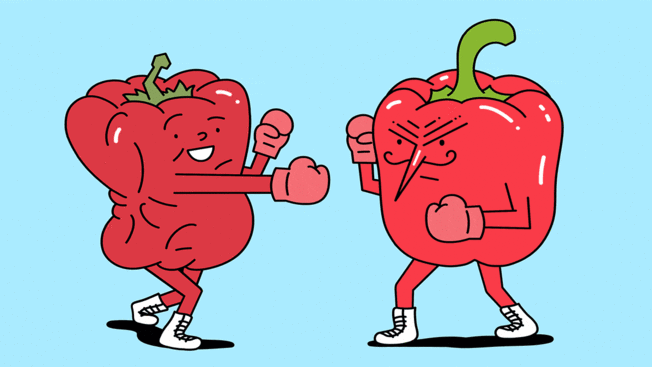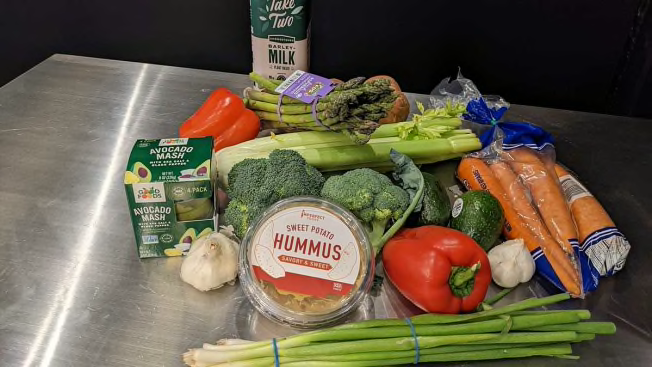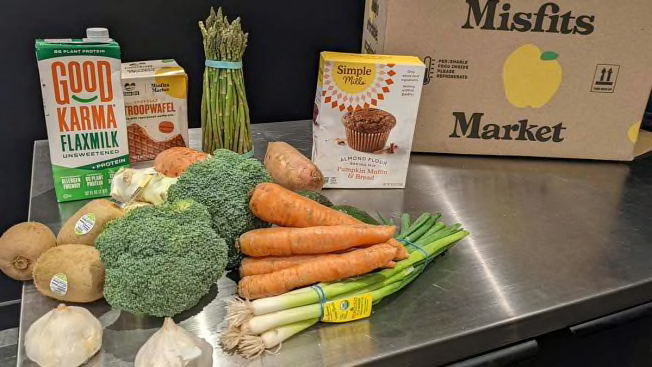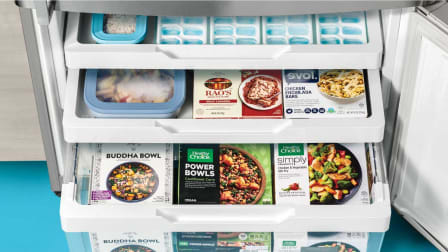Ugly Food Fight: Misfits Market, Imperfect Foods, and the Battle Against Food Waste
Both online grocers deliver salvaged produce. How good are the savings for the planet and your budget?

It may surprise you to know this, but baby carrots are a sham.
Instead of being plucked from mother nature’s garden at the peak of preadolescent perfection, most “babies” are actually the result of a salvage mission.
Their arrival traces back to the mid 1980s, when Bunny-Luv, one of California’s largest carrot growers, was seeing 70 percent of its carrot harvest not making it to the grocery store. Each day, some 400 tons of produce was too big, misshapen, or damaged to fit uniformly into supermarket-friendly packaging. A portion of the castoffs became animal feed, some got juiced, others were processed and paired with peas destined for the freezer section. And some got tossed.
Then Bunny-Luv owner Mike Yurosek had an inspiration: Using a potato peeler, a knife, and some trial and error, the “father of the baby carrot” transformed vegetables destined for the compost heap into crunchy orange gold.
Decades later, baby carrots constitute 54 percent of U.S. carrot sales. And today, more food sellers are attempting to pull off that trash-to-treasure maneuver, or something like it.
Food Waste Is a Huge Problem
The problem these companies aim to address is a big one: While more than 38 million people in the U.S. live in food-insecure households, Americans overall waste more than a third of our food supply. Half of that waste occurs at the consumption stage in homes or at restaurants, but each year 10.1 million tons of food are tossed at farms. Fruits and vegetables account for most of what’s thrown away.
In 2015, the Department of Agriculture and the Environmental Protection Agency announced the first-ever domestic goal to address food waste. Among other approaches, the agencies made it easier and more cost-effective for growers to donate surplus fruits and vegetables to soup kitchens, food banks, and homeless shelters, among other approaches. The aim is to cut food waste in half by 2030.
But getting supermarket shoppers to lose their disdain for imperfect fruits and vegetables is another important part of the solution, says Nina Sevilla, program advocate at the Natural Resources Defense Council. She says we should “normalize” the consumption of edible food that doesn’t necessarily look ready for its closeup.
Why We Balk at Blemishes
Misfits Market founder and CEO Abhi Ramesh and his investors are betting that consumers are prepared to make that adjustment. But to succeed they have to overcome years of ingrained consumer expectation.
“Consumers have been conditioned, to an extent, to look for this really great product,” says Joe Watson, a former director of produce at Rouses Markets, a chain of supermarkets in three southern states, and now a vice president at the Produce Marketing Association, a trade organization. He explains that while the USDA sets certain standards, retailers often “apply another level of a criteria that they want for their product.”
Take sweet peppers. The USDA assigns them one of three grades—Fancy, U.S. No. 1, or U.S. No. 2—based on criteria such as size and how well-shaped they are. Regardless of the grade, the peppers must also be free of decay and injury from hail, sunburn, disease, insects, and other causes.
But to differentiate themselves from their competitors, grocers may apply additional requirements. A common one for peppers: That they have four lobes, so they can stand up independently on kitchen counters. Watson, the former produce director, notes that at some grocers the peppers were so uniform that “day in and day out, customers could walk up with their eyes closed and pick one” and know exactly what it would look like.
Changing Hearts, Minds, and Palates
Others have tried–and failed–at making a go of selling imperfect produce.
In 2016, Whole Foods Market, Walmart, HyVee, and Associated Food Stores, among others, started to sell some misshapen fruits and vegetables. Many of the retailers created displays in their produce sections explaining why the selections were less than photo-ready and the prices so good. A Harris poll that year found that 62 percent of people surveyed said they would be somewhat open to eating “ugly produce" that tasted the same as non-misshapen products.
But after that initial wave of enthusiasm, grocers started losing interest. That’s because, after spending years marketing perfect-looking produce, re-educating consumers failed to pay off, industry observers say.
Soon, nearly all of the markets threw in the towel or found other ways to utilize misshapen produce. Whole Foods Market, for example, utilizes odd-looking produce in their prepared foods and smoothie stations.
Yet many consumers—58 percent, in one 2021 survey—continued to say they would opt for imperfect produce if it was offered at a discount.
Enter the online vendors, which have taken up where the grocers left off. While each outlet makes misshapen fruits and veggies the centerpiece of their offerings, they differ somewhat. Perfectly Imperfect, one of the smaller players, for example, lets customers select the size, frequency, and contents of their order, allowing them to choose boxes with names like Soup Lovers, Organic Mix, and Salad Bar. At Hungry Harvest, shoppers can select a curated harvest box of conventional or organic produce or customize one of their own.
Both Misfits Market and Imperfect Foods source their produce from growers who cultivate conventional and organic fruits and vegetables. Misfits works with about 100 produce growers throughout the year. Imperfect Foods doesn’t specifically break out food growers but has a roster of 1,200 farmers, producers, and food purveyors across the country.
How do they stack up up? To find out, I compared the offerings from Misfits Market and Imperfect Foods, which both deliver to my Brooklyn, N.Y., neighborhood, with my local Stop & Shop supermarket.
Putting Imperfect Foods and Misfits Market to the Test
I started with Imperfect Foods. There are two basic paths to navigating its website. One is to shop through their list of available items as you would at any online store. The other is to let the company do the choosing for you, based on a quick quiz of your situation and preferences. Intrigued, I opted for that approach.
I was asked how many adults, kids, and pets I was shopping for, and queried about my food preferences: Conventional or organic? Vegan, plant-based, or “I eat it all?” (Note that Imperfect and Misfits also carry non-produce foods, including meats, dairy, and pantry items, but only the fruits and vegetables are in any way misfits.)
Taking my answers into account, the folks at Imperfect pre-filled my cart with 12 items, including nine types of vegetables and three non-produce items. Once the food was selected, I was given the chance to delete items I didn’t want and add more that I did, making certain I remained at or above the $30 minimum needed to complete the order.

Photo: Brian Vines/Consumer Reports Photo: Brian Vines/Consumer Reports
So in the end my order was less mystery box, more curated shopping cart. As with online dating, I had an idea of what was coming but needed to reserve judgment until I was shaking hands with a Haas avocado.
Misfits Market has only one option, having discontinued its mystery box model after finding that most customers preferred to choose their own food. In fact, many people who did opt for the mystery box ended up throwing away the surprise foods that showed up at their door, the company says, contributing to the food waste problem, not solving it.
Instead, you are free to roam Misfit’s digital aisles building your grocery haul. During a three-day shopping window, you can add or remove items. Once your groceries cross the $30 order minimum you receive an auto confirmation.
I used the Imperfect Foods shipment to come up with the shopping list for my Misfits order. I also used that list when shopping at my local Stop & Shop in Brooklyn.

Photo: Brian Vines/Consumer Reports Photo: Brian Vines/Consumer Reports
Three days after placing my Imperfect order, I unboxed an assortment of veggies: a head of celery, a bunch of green onions and another of asparagus, a small bag of carrots, and two each of avocados, broccoli crowns, garlic heads, sweet potatoes, and red bell peppers. (The three non-produce items in my order were a package of Imperfect’s private label sweet potato hummus, a 40-oz. bottle of Take Two Unsweetened Barley Milk, and four small tubs of Goods Food Avocado Mash.)
The curated box of produce did not leave me breathless, but I was promised imperfect veggies, not a pony. My first impression was that nothing was oddly shaped or what I would deem “imperfect”—no bruising, pitting, or Instagram-worthy oddity. Overall, I was pretty happy with the selection and the quality of the produce.
For my Misfits order, I replicated all the vegetables that came with my Imperfect order, plus a few other non-produce items to get me over the minimum order size. And when the misfits arrived, I was once again left wondering what at all was imperfect about this food.
The Bottom Line
Here’s my final assessment.
Quality and taste: Between the two, I could see no obvious winner in the quality or taste of the produce. Even when I compared the supposedly less quirky items I selected at the supermarket, I would be hard pressed to discern which sweet potato, asparagus spear, or green onion came from which source.
Cost: There was also very little difference in terms of cost: $21.43 for the produce from Misfits, $23.62 for the same mix at Imperfect Foods, and $23.40 at my local Stop & Shop.
Delivery: The two online services did charge for delivery, but again the differences weren’t huge: $5.50 at Misfits vs. $4.99 at Imperfect Foods. Yes, the delivery costs are an expense you don’t have picking up food at the supermarket, but the convenience might be worth it to some people, especially those who don’t live near a supermarket.
The biggest downside: Having to order more food than you might want to get up to the $30 minimum. But you might be able to offset that by going in on an order with neighbors.
The biggest upside: Besides convenience, you might be helping limit food waste by eating things otherwise headed to the trash.
Overall: After considering the costs, the quality of the experience, and the quality of the products, I call it a draw. Whether or not you use one of these services is really a matter of your individual taste, level of access to the internet or fresh produce, and attitude about sustainability.
I imagine someone could get more granular in their analysis by comparing packaging, carbon footprint, and labor and farming practices of suppliers, not to mention aesthetics and taste, before making a decision about where their next bell pepper is coming from.
But for me, as much as I enjoy squeezing my own melons and selecting produce in person, now that I’ve broken the seal, I’d be open to an ugly food delivery on my doorstep every now and again.




















